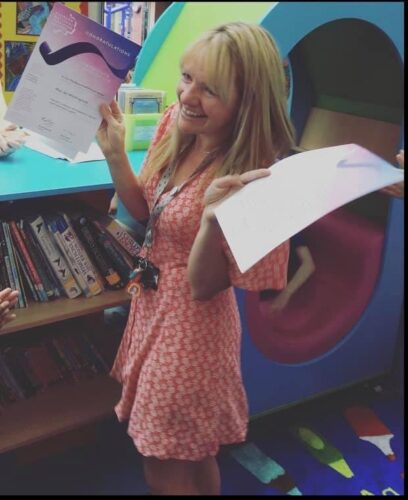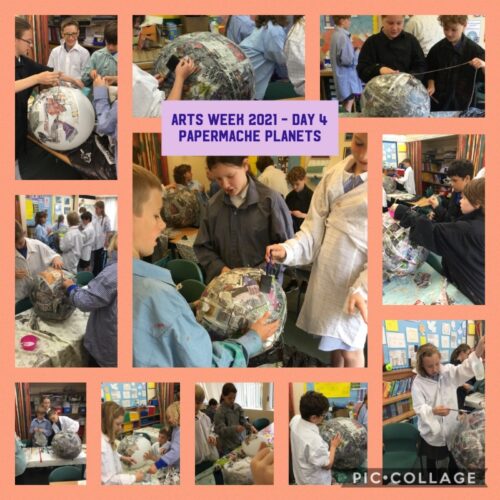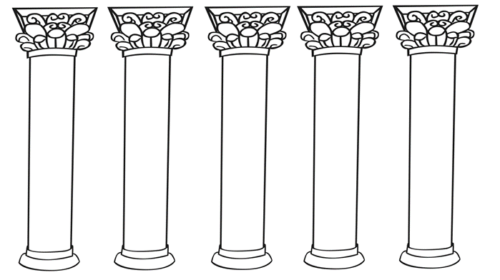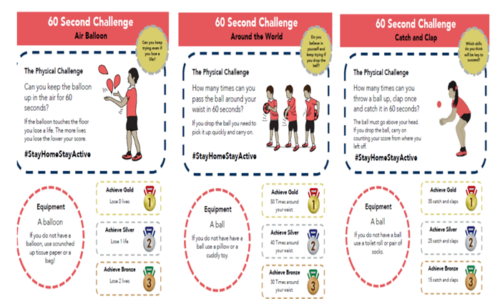Here are your spellings for this week, please practise them at home ready for your test next Friday 24th September 🙂
Any problems let me know,
Miss Horton
Here are your spellings for this week, please practise them at home ready for your test next Friday 24th September 🙂
Any problems let me know,
Miss Horton
Here are your spellings for this week, please practise them at home ready for your test next Friday 24th September 🙂
Any problems let me know!
Thanks,
Miss Horton
Welcome back Dragonflies!
We hope you had a lovely summer holidays and that you are ready for another exciting term at St John’s. We have lots of things to look forward to this term, have a look at the newsletter and an overview of our subjects to find out more.
Dragonflies Autumn Newsletter 2021
Dragonflies Topic Overview Autumn 2021
We can’t wait to see you all tomorrow 🙂
Mrs Hollis & Miss Horton
We are all so proud (but not surprised!) of Miss Whit being named as a ‘Lockdown Hero’ by The Pearson National Teaching Awards. She goes above and beyond for the school and every day it’s clear to see that children have her heart. Congratulations Miss Whit – you’re an absolute star and we’re all very lucky to work alongside you everyday!

Today we have been continuing our artwork based on Oliver Jeffers book ‘Here we are: Notes for Living on Planet Earth. We have been thinking about our place in the world and the universe. We are creating our own paper mache solar system – a very sticky job!

Hello Owl Class! Welcome back to all of you; we can’t wait to see you all.
Here is an overview of our topics for this term plus some information about PE and homework.
Owl Class Newsletter Summer 2021
Owl Class Topic Planner Summer 2021
Mrs Hollis and Miss Horton
9.15am – Morning chat and register (meeting)
English
10:30 – Breaktime
Maths
RE
12noon – Lunch
1:10 – Chat about afternoon activities (meeting)
PSHE
PE
2.50pm – End of the day catch up (meeting)
English:
Y5 LO: To identify, describe and represent the position of a shape following a reflection or translation, using the appropriate language, and know that the shape has not changed
Y6 LO: To describe positions on the full coordinate grid (all four quadrants)
Today we will be looking at all four quadrants Watch the PowerPoint attached and then complete the worksheet for your year group. The stars tell you how difficult the sheet will be (*=developing **=expected ***=greater depth). You must do one reasoning & problem solving sheet and one varied fluency sheet. You can mark your work using the answers provided.
You can take a picture of your completed maths sheets and attach them to the assignment by clicking ‘Add work’. Remember to press ‘Hand-in’ so I know when you have completed your work.
*If you are finding this tricky, have a go at the Y4 work about position and direction to refresh your memory.
Y4 Powerpoint – Draw on a Grid
Y6 – Powerpoint – Position and Direction
RE:
In RE today I want you to think about what you already know about the religion of Islam. It might have been a while ago since you covered it at school so you’ll have to dig deep into your memory!
Have a go at completing this circuit. You can set a timer on Alexa/Ipad/Computer for one minute for each exercise. Count how many repetitions you do for each exercise.
1. Core: Plank
2. Legs: Squat hold against the wall (backs straight against the wall and knees together, bend legs so knees are at a 90 degree angle and hold)
3. Cardio: Shuttle runs
4. Core: Arch hold (lying on tummy, hold arms above head and lift straight legs off the floor like superman)
5. Arms: Push-ups (can decide to go on knees or feet)
6. Cardio: Star jumps
7. Core: Sit-ups
8. Legs: Rock back jumps (on a mat – sit down, rock to shoulders, rock back to stand up and do a straight jump, repeat)
9. Cardio: Burpees
10. Core: Tuck hold (on a mat – sit back and lift feet off of floor in a tuck shape and balance)
11. Arms: Tricep dips (on a chair or step– sit down, hands facing forwards, lift bottom off chair and move feet away, bend at the arms and push back up again)
12. Cardio: Skipping
You can record your number of repetitions on the Circuit record sheet
Have a good day, and a lovely weekend!
Miss Horton 🙂
Good Morning Owls! It’s Miss Horton here 😊 I hope you’ve all had a good week so far, you can tell me all about it at our TEAMs meeting this morning. Mrs Hollis said you’re all getting to grips with using TEAMs now, which is great news.
Here is your timetable for today but remember this is only a guide and you can work through the lessons at your own speed. Please attend the spelling test meeting for your year group (don’t worry you won’t have to announce your scores to everyone!). I would like to see as many of you as possible at our 9am meeting so we can all say hello to each other.
I will be online all day to answer any questions or queries you have. If you have any problems please use the ‘Ask the Teacher’ channel.
9.15am – Morning chat and register (meeting)
9:45 – Y5 Spelling Test – bring your pen and paper! (meeting)
10:15 – Y6 Spelling Test – bring your pen and paper! (meeting)
You can fit your English lesson in between these meetings (they shouldn’t last too long)
10:30 – Breaktime
11am – Maths
12noon – Lunch
1:10 – Music with Mr Butler (meeting)
1:50 – Computing
2:30 – Reading
2.50pm – End of the day catch up (meeting)
English:
Follow this link: To write a recount (thenational.academy)
Today we will be looking at position and translation in the first quadrant. Watch the PowerPoint attached and then complete the worksheet for your year group The stars tell you how difficult the sheet will be (*=developing **=expected ***=greater depth). You must do one reasoning & problem solving sheet and one varied fluency sheet. You can mark your work using the answers provided.
You can take a picture of your completed maths sheets and attach them to the assignment by clicking ‘Add work’. Remember to press ‘Hand-in’ so I know when you have completed your work.
*If you are finding this tricky, have a go at the Y4 work about position and direction to refresh your memory.
Powerpoint – The First Quadrant
Y5 RPS Position in the First Quadrant
Y5 VF Position in the First Quadrant
Powerpoint – Describe Position (Y4)
Music:
Mr Butler will be teaching a live music lesson at 1:10 via teams. Please follow this link to take part: https://emea01.safelinks.protection.outlook.com/ap/t-59584e83/?url=https%3A%2F%2Fteams.microsoft.com%2Fl%2Fmeetup-join%2F19%253ameeting_NTdhOTNkZjQtN2U2ZS00M2NlLWFiZmMtNzA5MmEwY2Y3YTg4%2540thread.v2%2F0%3Fcontext%3D%257b%2522Tid%2522%253a%25227b8dd277-fc97-449d-a6ac-0535e8bf8d69%2522%252c%2522Oid%2522%253a%2522fc02ea6d-9874-4af0-b55b-cacfb3eca8fe%2522%257d&data=04%7C01%7C%7C3b5c3b400fcc48abf23308d8b7d6c6c9%7C84df9e7fe9f640afb435aaaaaaaaaaaa%7C1%7C0%7C637461480363716608%7CUnknown%7CTWFpbGZsb3d8eyJWIjoiMC4wLjAwMDAiLCJQIjoiV2luMzIiLCJBTiI6Ik1haWwiLCJXVCI6Mn0%3D%7C1000&sdata=SPWX49aYARW9D2YIwQrmwG4NU9Z2DRvzjsGLty%2B3b8k%3D&reserved=0
Computing:
Good Morning Owls
I hope you all manage to join us for our Microsoft Teams meeting at 9am this morning. This is a chance for us all to get our heads round how it works and to get to see each other on screen. We’re hoping to start using teams more as time goes on, but while we’re all getting used to how everything works you’re home learning tasks will remain on the website as well as teams in case you’re struggling to find anything. If you are having any trouble with Teams or need anything explaining please email me at horton.z@ruyton.shropshire.sch.uk
Here are your home learning tasks for today:
English:
Following on from the English work you have been doing this week the next lesson is about developing an understanding of words associated with chaos and confusion. You will be introduced to new vocabulary, identify word pairs and synonyms and apply the vocabulary in sentences.
Maths:
Like yesterday we are continuing to look at dividing fractions by integers. You can watch the video or look at powerpoint – or both! The stars tell you how difficult the sheet will be (*=developing **=expected ***=greater depth). If you are in year 5 do the developing sheet first, you may find it easy and want to try a harder sheet. You must do one reasoning & problem solving sheet and one varied fluency sheet. You can mark your work using the answers provided.
Y5/6 – Powerpoint – Dividing by Integers (2)
Y5/6 – Varied Fluency – Dividing by Integers (2)
Y5/6 – Reasoning & problem solving – Dividing by integers (2)
If you’re finding it a bit tricky, have a go at these sheets on calculating quantities of amounts:
Y4 – Powerpoint – Calculate Quantities
Y4 – Reasoning & Problem – Calculate Quantities
Y4 – Varied Fluency – Calculate Quantities
Religious Education:
The first half of this term we will be learning about the Pillars of Islam. Today I want you to have a look at these buildings. What are the pillars for? Why do the buildings need them? What would happen if they weren’t there?



Are pillars always physical? What might someone mean by someone being ‘a pillar of the community?
Have a think about our school rules. How are these like pillars? What would happen if we didn’t have any rules?
On these pillars I would like you to write some beliefs/values/rules you use in your everyday lives. These could link to our school values. For example, I believe that you should treat everyone with respect and always be kind to others. Put your pillars into order of importance. Ask somebody at home (or at school) if they would put them in the same order as you? Will everyone put them in the same order?
(You don’t have to print these pillars off you can just write them into your books or type it up on your computer – this just gives you an idea of how you could present your work)

PE:
Have a go at these challenges. I’ll have a go too – I wonder if you’ll beat my score! Let me know how you get on. Can you think of a challenge that you can set for the whole class to do next week? The best ones will be next weeks challenge!

Music:
OWLS Super Mega Ultra Important Super Fun Quiz ANSWERS:
Concert, Soprano, Bass
Soprano, Concert, Bass
Ladies of Hollywood
Resin
It stopped the wood from being scratched by long fingernails
It becomes louder / more resonant
The strings!
Strings used to be made from cat gut. The ‘nut’ used to be made from bone. 🙁
70 cm
About 30 years
80mm
The electric bass guitar / the double bass
Extras:
Record your work in the book sent home from school. Please send copies/photos of your work to me at horton.z@ruyton.shropshire.sch.uk.
Have a great day,
Miss Horton 🙂